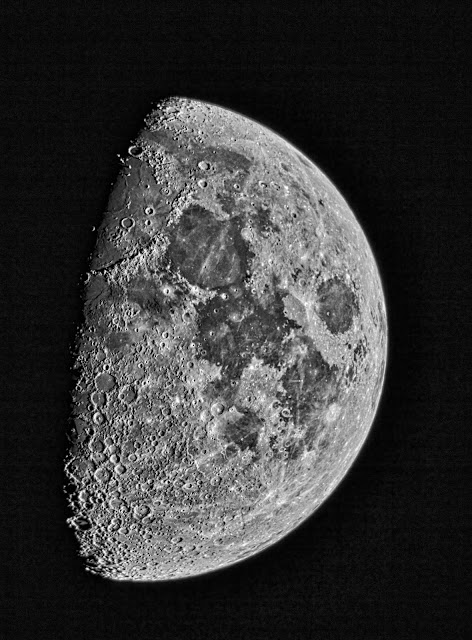As promised in the prior post, here is the Moon, just past what they call "First Quarter".
Now, perhaps you are wondering why they don't call it "Half Moon" because it appears that way to an observer here on Earth. Well, it is a matter of perspective. When the Moon is in this lighting it has completed 1/4th (one quarter) of its orbit around the Earth.
Anyway, I took about seven images of the Moon with my Celestron C6 telescope (without a focal reducer) and a Canon T3i camera body attached to it. Each image I changed the exposure time to capture details that a single exposure would either make too dark or too light to show finer details.
As you can see, an individual image just doesn't capture the wide range of detail and contrast.
That is why we will use a program (and there are many out there) to produce a HDR or high dynamic range photo.
I used HDRtist (a Mac app) to combine the images into one HDR, which I then rotated to the right to give it its proper viewing angle. (Note: this is in color due to atmospheric issues that night)
But because we know the the Moon is not made out of cheese (and the Earth is round, not flat!) I desaturated the image to make it gray scale instead of color:
Finally with some post-processing with Luminar 2018, working with contrast and sharpening, etc. here is the result:
One more: Earth's Moon is normally seen in subtle shades of grey or yellow. But small color differences can be greatly exaggerated to make the small differences more apparent. The familiar Sea of Tranquility (Mare Tranquillitatis) is the blue area right of center.
Though exaggerated, the different colors are recognized to correspond to real differences in the chemical makeup of the lunar surface - blue hues reveal titanium rich areas while orange and purple colors show regions relatively poor in titanium and iron. Calibrated by rock samples from the Apollo missions, similar multicolor images from spacecraft have been used to explore the Moon's global surface composition.
Now, perhaps you are wondering why they don't call it "Half Moon" because it appears that way to an observer here on Earth. Well, it is a matter of perspective. When the Moon is in this lighting it has completed 1/4th (one quarter) of its orbit around the Earth.
Anyway, I took about seven images of the Moon with my Celestron C6 telescope (without a focal reducer) and a Canon T3i camera body attached to it. Each image I changed the exposure time to capture details that a single exposure would either make too dark or too light to show finer details.
That is why we will use a program (and there are many out there) to produce a HDR or high dynamic range photo.
I used HDRtist (a Mac app) to combine the images into one HDR, which I then rotated to the right to give it its proper viewing angle. (Note: this is in color due to atmospheric issues that night)
But because we know the the Moon is not made out of cheese (and the Earth is round, not flat!) I desaturated the image to make it gray scale instead of color:
Finally with some post-processing with Luminar 2018, working with contrast and sharpening, etc. here is the result:
One more: Earth's Moon is normally seen in subtle shades of grey or yellow. But small color differences can be greatly exaggerated to make the small differences more apparent. The familiar Sea of Tranquility (Mare Tranquillitatis) is the blue area right of center.









No comments:
Post a Comment